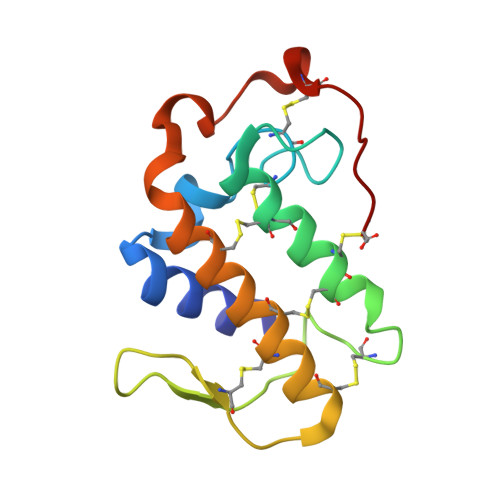Structural, functional, and bioinformatics studies reveal a new snake venom homologue phospholipase A2 class.
dos Santos, J.I., Cintra-Francischinelli, M., Borges, R.J., Fernandes, C.A., Pizzo, P., Cintra, A.C., Braz, A.S., Soares, A.M., Fontes, M.R.(2011) Proteins 79: 61-78
- PubMed: 20878713
- DOI: https://doi.org/10.1002/prot.22858
- Primary Citation of Related Structures:
3JR8 - PubMed Abstract:
Phospholipases A₂ (PLA₂s) are enzymes responsible for membrane disruption through Ca(2+) -dependent hydrolysis of phospholipids. Lys49-PLA₂s are well-characterized homologue PLA₂s that do not show catalytic activity but can exert a pronounced local myotoxic effect. These homologue PLA₂s were first believed to present residual catalytic activity but experiments with a recombinant toxin show they are incapable of catalysis. Herein, we present a new homologue Asp49-PLA₂ (BthTX-II) that is also able to exert muscle damage. This toxin was isolated in 1992 and characterized as presenting very low catalytic activity. Interestingly, this myotoxic homologue Asp49-PLA₂ conserves all the residues responsible for Ca(2+) coordination and of the catalytic network, features thought to be fundamental for PLA₂ enzymatic activity. Previous crystallographic studies of apo BthTX-II suggested this toxin could be catalytically inactive since a distortion in the calcium binding loop was observed. In this article, we show BthTX-II is not catalytic based on an in vitro cell viability assay and time-lapse experiments on C2C12 myotube cell cultures, X-ray crystallography and phylogenetic studies. Cell culture experiments show that BthTX-II is devoid of catalytic activity, as already observed for Lys49-PLA₂s. Crystallographic studies of the complex BthTX-II/Ca(2+) show that the distortion of the calcium binding loop is still present and impairs ion coordination even though Ca(2+) are found interacting with other regions of the protein. Phylogenetic studies demonstrate that BthTX-II is more phylogenetically related to Lys49-PLA₂s than to other Asp49-PLA₂s, thus allowing Crotalinae subfamily PLA₂s to be classified into two main branches: a catalytic and a myotoxic one.
Organizational Affiliation:
Departamento de Física e Biofísica, Instituto de Biociências, UNESP - Univ Estadual Paulista, Botucatu-SP and Instituto Nacional de Ciência e Tecnologia em Toxinas, CNPq, Brazil.















